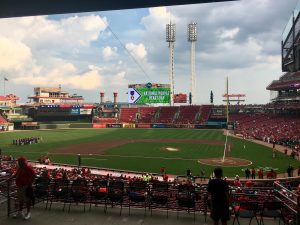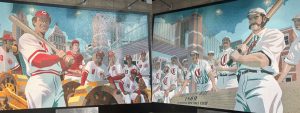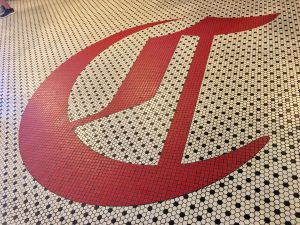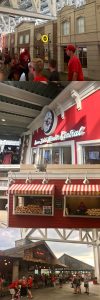There’s a reflexive wariness in listening to discussions of great pitchers of other eras, a little voice that pipes up to remind you that while those hurlers were undoubtedly amazing, stories have a way of growing in the telling.
I saw Bob Gibson [1] strike out 22 Reds during a tornado that tore the facade right off the stadium, and he never went to three balls on a hitter.
That’s nothing, I was in the park when Robin Roberts [2] pitched a complete game and took out a German machine-gun nest during the seventh-inning stretch.
But I could feel myself reaching for superlatives while watching Jacob deGrom [3] at work against the Phillies on Saturday afternoon.
It wasn’t just the desire, evident in deGrom hurrying back to the mound after a rain delay to ensure there was no way he ran afoul of Dave Eiland [4]‘s 45-minute limit to continue, or his insistence on finishing what he started.
Nor was it the results, though they spoke for themselves: deGrom hurled his third career complete game, topped 200 strikeouts for the year, lowered his ERA to 1.71, and turned in his 22nd straight start in which he allowed three runs or less. (Good enough? That’s Goodenesque.)
No, it was the way deGrom left you with the sense that good as he was, he had another gear still, one he engaged when a perilous situation demanded it.
In the sixth, with a runner on second, two out and deGrom defending a 1-0 lead, he at first looked like he wanted no part of the dangerous Carlos Santana [5]. But when Santana fouled off a 3-0 fastball, deGrom saw an opening and went to work, befuddling Santana with a fastball on the outer edge and a slider that started on his hands and broke in.
Rhys Hoskins [6] came up as the tying run in the eighth, and deGrom showed him three sliders on the corner, for a 2-1 count, then turned to the fastball, wrecking Hoskins’s rhythm and messing with his eye level and punching him out on a high 2-2 heater.
In the ninth, deGrom surrendered a leadoff single and then coaxed a double play on the first pitch to Wilson Ramos [7], defanging a normally sharp-toothed Met killer. He then blitzed Nick Williams [8] with 98 and 99 MPH heat, the hardest he’d thrown all day despite having a pitch count above 100.
Those are fearsome hitters on a first-division club with October aspirations, and their showdowns with deGrom felt like no contest. The only blemish came in the seventh, when an overeager Amed Rosario [9] tried to turn a fielder’s choice into a double play and wound up handcuffing deGrom with an awkward throw at first. The ball got away and a run scored, but deGrom caught Odubel Herrera [10] having broken just slightly left from first, making him a baserunner, and upon review, Jeff McNeil [11] tagged Herrera a split-second before he returned to refuge on the bag. It was a bit of sloppy Metsiness in an otherwise crisp afternoon, a reminder of betrayals past, but it was gone in a moment and all was well [12].
Should deGrom win the Cy Young [13] award? My preferences are obvious; I also don’t get a vote. All I’ll say is if the current state of affairs continues, the baseball writers will have a fascinating choice among three superb candidates and three competing philosophies. DeGrom has the gaudy ERA and the best numbers not dependent on what teammates do or don’t do; Max Scherzer [14] has the wins, which are still currency regardless of what exchange rate you think they merit; and Aaron Nola [15] is the horse whose team is likely to be playing in October because of his efforts.
There will be plenty of ink and pixels spilled over whatever verdict is rendered. I’m just relieved to say that none of those choices would be an injustice. And I can’t wait to see deGrom take the hill again, to leave me once more reaching for superlatives.
* * *
The fourth and final new park on this year’s ballpark tour was Great American Ball Park, the Reds’ home on the shores of the Ohio River in Cincinnati.*
It’s a park I’m very glad I saw, not so much because I liked it — it was adequate — but because it made me rethink some things about ballparks in general and the retro-classic parks in particular. Guaranteed Rate Field made me realize the importance [17] of a ballpark’s integration with its surroundings and context within them; GABP made me rethink the importance of what use a ballpark makes or doesn’t make of its setting.
When I visited PNC Park [18], I was wowed by the view of the Roberto Clemente [19] bridge and the Pittsburgh skyline beyond it, but questioned how much credit the Pirates deserved for that aspect of the park. They didn’t build that, I pointed out, filching a line from politics. This struck me as a fair question at the time, but I’ll withdraw it after revisiting Nationals Park a few weeks ago and then seeing GABP.
I liked Nats Park well enough when I first saw it, but it’s fallen in my estimation as I’ve seen more stadiums. It’s nothing special to approach, its interior is fairly generic, and it makes zero use of D.C. as a backdrop — you could be anywhere. (Plus its menu is basically Citi Field plus Ben’s Chili Bowl.)
GABP nails the approach that Nats Park fails. Walking over from my downtown hotel, I stopped off to admire the John A. Roebling Suspension Bridge (a prototype of sorts for the Brooklyn Bridge), strolled through a playground and walked across a rope bridge that the kids weren’t using, sat for a pleasant spell on a riverside swing, and paused for a beer across the street. Then I joined the throng of Reds fans entering the park. Throughout the trip, the Ohio River was in front of me, with Kentucky beyond.
Then I got inside GABP and largely lost the river. To be fair, the upper levels have views of it, and when I go back to Cincinnati I’ll choose a seat up there and see if I feel differently. But for many fans at GABP, the river and the view across it are obscured by the center-field bleachers and the Reds’ singularly dopey faux steamboat and accompanying “power stacks,” which spit fire, steam and fireworks depending on what’s happening during the game. It’s a dumb contrivance that shortchanges what it’s meant to celebrate.
In case you’re wondering, a batter at GABP is looking southeast, which once would have been stadium-design heresy. Baseball still has a rule on the books that says it’s “desirable” that the home plate-pitcher’s rubber-second base axis run east-northeast, in order to keep the sun from getting in the batter’s eyes. But it’s not a hard-and-fast rule, as this article [21] and its rather useful graphic show. The White Sox were the first to buck tradition, and other teams followed suit when there wasn’t an epidemic of blinded batters. In fact, if you look at that graphic, you’ll find some of the better views in baseball stadiums down in that southeast arc, most notably PNC and the new Busch Stadium. And you’ll find GABP.
So the Reds got that right. But that makes me scratch my head more. Rather than make the most of the riverfront setting, it feels like the park’s designers — HOK/Populous again — made the least of it.
The rest of the park is OK, but a bit bland, with equal parts nice touches and oddities. I liked the dual murals of the 1869 Cincinnati Red Stockings and the mid-1970s Big Red Machine, which offer a lovely evocation of the team through time. (Notable: both murals feature the Roebling bridge. Setting! It’s important!) I liked discovering that one of the taprooms has the old Reds “C” recreated in tile. A missing chunk of stands known locally as “the Gap” offers a peek at downtown. I snapped pictures of Johnny Bench [24]‘s statue and posed for an inept selfie with Mr. Red and Rosie Red. (Mr. Red predates Mr. Met, so leave him alone.) Leaving the brewery for the game, I noticed a square in the lobby commemorated the location of first base at Riverfront — it was largely unnoticed by the beer-seeking hordes, but at least it was there. (Here’s Greg [25] on GABP, featuring a cameo by Al Leiter [26].)
The food at GABP was good — I ate a decent pulled-pork sandwich, then got a helmet cup of ice cream and was pleasantly surprised to discover I could load it with as many toppings as I wanted, for no extra charge. The customer-service folks were invariably polite and obviously trained to help you do things rather than to hinder you, a refreshing change from Citi Field and its surly theater of hostility.
On the other hand, whoever designed GABP’s interior had a weird fetish for Potemkin buildings. GABP is full of faux storefronts and buildings within buildings, most ludicrously an ersatz moonshiner’s cabin, only it’s supersized and built to exacting building codes and so doesn’t resemble a moonshiner’s cabin at all. The first of these buildings feels like a quirk. The second and third ones strike you as weird. Then the fourth, fifth and so on roll into view and you wonder what, exactly, is going on here.
Is that a big deal? No, of course not. But it left me thinking that the folks behind GABP spent too much time on stuff that didn’t particularly matter and not enough on what did. And given the park’s beautiful surroundings, that’s a shame.
* OK, so the Rangers play an afternoon game on Sept. 19 and I’m thinking of flying to Dallas-Fort Worth that morning, seeing the game and flying back that night. Which would get me to 28 of 30 parks, with just Atlanta and Miami to go. It’s a really dumb idea. It also sounds like fun.



